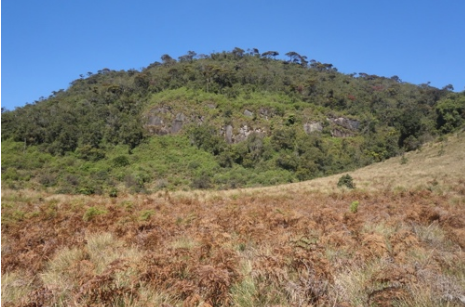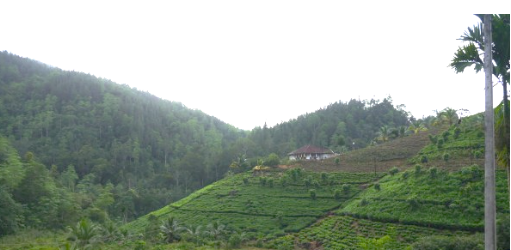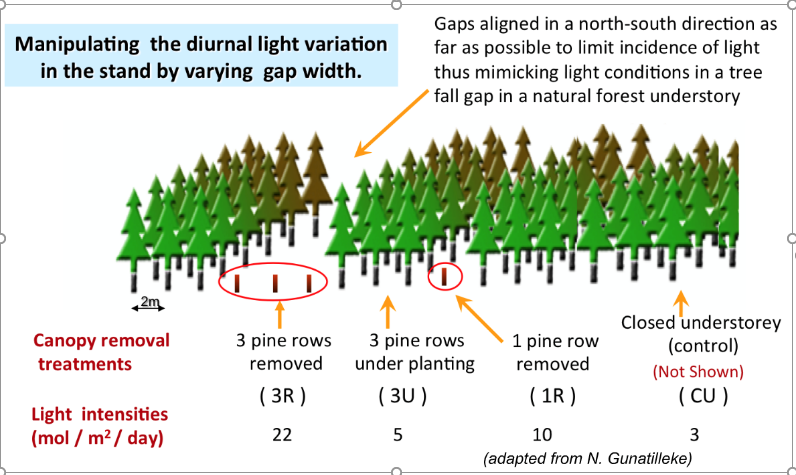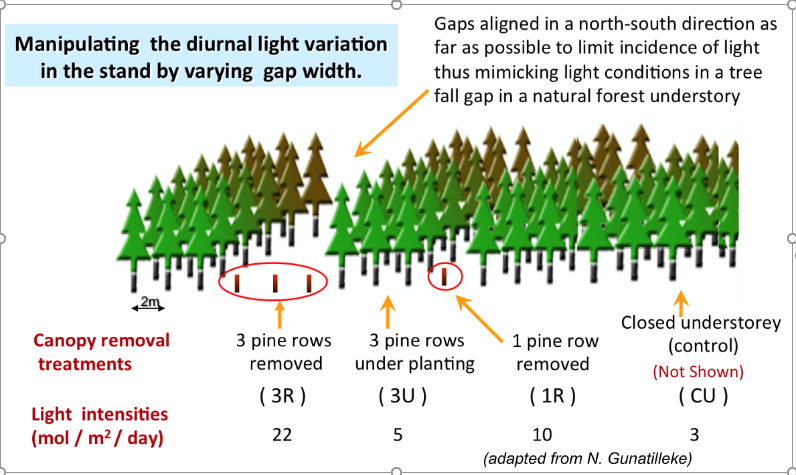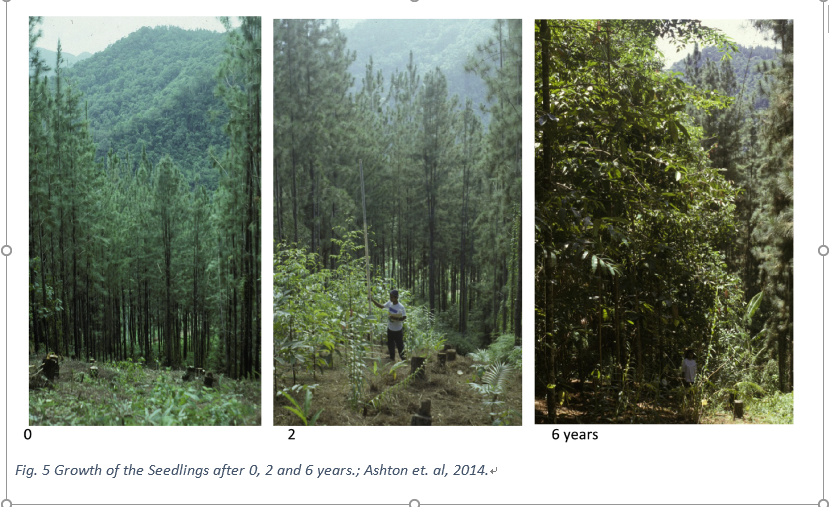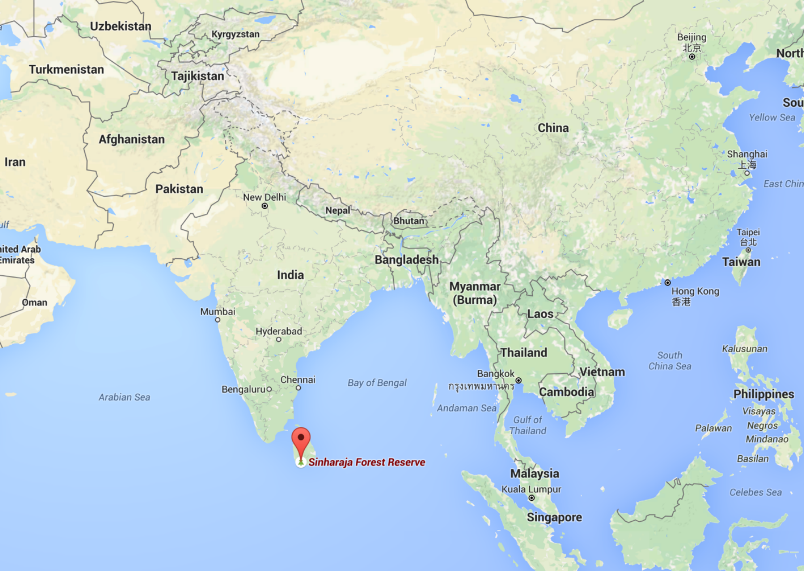
Case Study Forest Restoration Using Relay Floristics in Sri Lanka
Details
Introduction
Forest restoration attempts are often conducted in environments that have been significantly altered by prior human intervention, making it consequently difficult for the native vegetation that developed of millions of years to adapt and re-colonize these areas. The following case study shows an innovative approach of enabling native vegetation to re-establish by using exotic species from other ecosystems to create forest conditions the native vegetation can thrive in. As severe erosion and anthropogenic disturbance has altered the landscape in China as well, this case study provides valuable lessons on how to re-establish native vegetation.
Background
The following case study is located in Sri Lanka in the buffer zone of the Sinharaja Forest Reserve and was established in 1991 by researchers at the University of Peradeniya.
Fig. 1 Location of the project site in the SInharaja Forest Reserve; Source: Google Maps
| Fig. 2 Grasslands with Bracken fern in Sri Lanka, Source: https://mbgecologicalrestoration.wordpress.com/category/sri-lanka/ |
Similarily, earlier reforestation attempts using native vegetation have also failed, as the prevalence of fire and the degraded soil conditions have made it impossible for the shade-adapted and fire-intolerant native species to survive.
Acknowledging that the ecosystem that has established now cannot be brought back in a short time with the native species at hand, the Sri Lankan Forest Department started using the exotic pine tree species Pinus caribaea from Northern Central America to reforest the lowland everwet and intermediate climates while Pinus patula was planted in montane regions.
| Fig. 3 Pinus caribaea plantations in the lowlands; Source: https://environment.yale.edu/tri/fellow/2037/ |
Restoring the Native Forests with Relay Floristics
While in most of the country the pine was left as it was in the Sinharaja Forest Reserve researcher regarded the pines instead of a nuisance and hindrance as an opportunity and great help for restoring the native forests.
Based on prior attempts it was clear that the native vegetation could not re-colonize the areas on their own, the question was what would enable it to re-colonize. During this time, two major theories of forest succession prevailed: the theory of relay floristics and initial floristics. Initial floristics describes the idea that during the initial establishment phase after a disturbance all kinds of plants are already present – including late successional species as much as early successional ones. They grow up together but the early successional species grow faster and are eventually outcompeted by the more shade-tolerant, slower-growing later successional species which grow underneath the early successional’s canopy.
The other theory of relay floristics describes the idea that plants of different successional stages arrive at different points in time in the disturbed site because the site conditions are too bad to facilitate later successional species. Thus, once early successional species have improved the soil and provided shade etc. the later successionals can establish.
Generally speaking, tropical forests operate under initial floristics, having all seed material present and different plants eventually outcompeting each other. In the Sri Lankan case, however, the ecosystem had been degraded to a point where the ecosystem had been reverted to a different successional “threshold”, meaning it had stabilized at a different successional stage where suddenly fire dominated. This prevented the different species from all being able to establish at the same time. Any hope to move the successional trajectory along therefore lays on a relay floristics approach, where certain tree species “prepare the ground” for others – which is exactly what was done in this case study through the use of the exotic pine. Pine, initially dominating the canopy, was used as a cover in order to restore the native species which would be growing underneath and finally be replacing the canopy.
The Enrichment Trial
Using the exotic pine as a cover, the scientists at the University of Peradeniya and Yale University planted native species in the understory. The tricky part was, however, to identify just how much light the native trees would need in order to survive and grow optimally. Therefore, in a series of different treatments different light conditions where created and evaluated the native species evaluated for growth and survival rates. The following variations were studies: 1. Large canopy gaps, 2.) small canopy gaps, 3.) in the actual understory of 3 rows of pines but gaps on each side allowing for angled light to come in, 4.) in the closed understory
Fig. 4 Different Variations in Enrichment Trial; Adapted from ELTI and N. Gunatilleke |
Amongst the species planted were different species of the genus Shorea and Mesua ferrea, but also sugar palm, rattan and mahogany. Most plants were in the family of Dipterocarpaceae. Most were endemic to the region, site specific to the trial site and classical late-successional canopy dominants of the mature forests of Southwest Sri Lanka. Site specificity was determined according to their topographic requirements (e.g. low- or midslope) which is a variable of soil conditions and available precipitation. Half of the trees planted were also defined as economically important timber and non-timber species.
In the results the species were ranked for their growth performance, mortality and potential use for humans. The optimal growth conditions varied species by species. However, generally full sun ranked as the worst condition while most species grew well when some degree of the canopy was opened. Classical understory species and NTFPs like Cardamom, grew well directly underneath the pine with very little light available. Three rows of pines removed worked best for all species in average. Growth rates and preference for more or less opening of the canopy were directly related to the species’ shade tolerance.
Aside from shade, three other potential inhibitors for the re-establishment of native species underneath pine were found: 1.) groundstory fires 2.) allelopathy of leaf litter in the plantation species, 3.) decreased soil moisture available due to root competition.
Especially groundstory fires were impacting success severely, so that fire prevention measures were concluded to be essential when trying to re-establish native forests.
| Fig. 5 Growth of the Seedlings after 0, 2 and 6 years.; Ashton et. al, 2014. |
Relevance for BFS’ Work on Forest Restoration in Miyun
This case study brings home several valuable lessons that can be incorporated in BFS’ future work in the Miyun watershed:
It supports the prior forest management approach BFS has taken, where it is thinning and trying to convert present monocultures of Pinus tabuliformis and Platycladus orientalis through introducing other, later-successional tree species. As seen in the Sri Lankan example, successful establishment of such species is a fine balance between ecological knowledge of difference species’ favored light and topographic conditions and a well-designed system of different field trials that systematically records the best silvicultural methods for re-establishing native species. As BFS is currently strongly relying of generic silvicultural recommendations based on experiences in different countries, it would be beneficial for BFS to partner with a local research institution (e.g. Beijing Forestry University or Chinese Academy of Sciences) to systematically develop a series of field trials to establish the best methods for re-introducing native species into the forest ecosystem underneath the afforested species of pine and oriental Thuja.
The lack of late successional, heavy-seeded species in Sri Lanka also shows that aside from the sheer enrichment plantings, the natural recruitment of late-successional, native species on such plots should be monitored after a larger number of years when the originally planted species have reached maturation. It is possible that the recovered vegetation is lacking certain species which should be enrichment planted in the future. As the landscape in Miyun is due to low precipitation prone to fire, it would also be interesting to monitor on such plots how the vegetation is influenced if frequent ground story burns occur.
The underplantings in Sri Lanka also taught a valuable lesson in terms of integrating NTFPs into reforestation efforts – in addition to native species for water quality purposes, in areas closer to villages more fruit bearing or other kinds of NTFP providing trees and understory plants could be encouraged.
The relay floristics approach researchers eventually resorted to could be an interesting solution for the shrub-dominated areas of the Miyun watershed: several plots could be created in order to see if these shrub areas are in a stage of arrested succession or cannot ecologically support forests. This could be done by planting early successionals that can withstand poor soil conditions like Pinus tabuliformis or other early successionals that haven’t been used as much in the afforestation efforts formerly done by the government.
Acknowledgement
This case study paper using material published n the case study on “Forest Rehabilitation in Old Pine Plantations in Sri Lanka” for the online course “Introduction to Tropical Forest Restoration” of the Environmental Leadership & Training Initiative (ELTI).
Sources
Ashton, M. A., et al. (1997). "Restoration of a Sri Lankan Rainforest: Using Caribbean Pine Pinus caribaea as a Nurse for Establishing Late-Successional Tree Species." Journal of Applied Ecology 34(4): 915-925.
Ashton, M. A., et al. (2014). "Restoration of rain forest beneath pine plantations: A relay floristic model with special application to tropical South Asia." Forest Ecology and Management 329: 351-359.
Ashton, M. A., et al. (2001). "Restoration pathways for rain forest in southwest Sri Lanka: a review of concepts and models." Forest Ecology and Management 154: 409-430.

